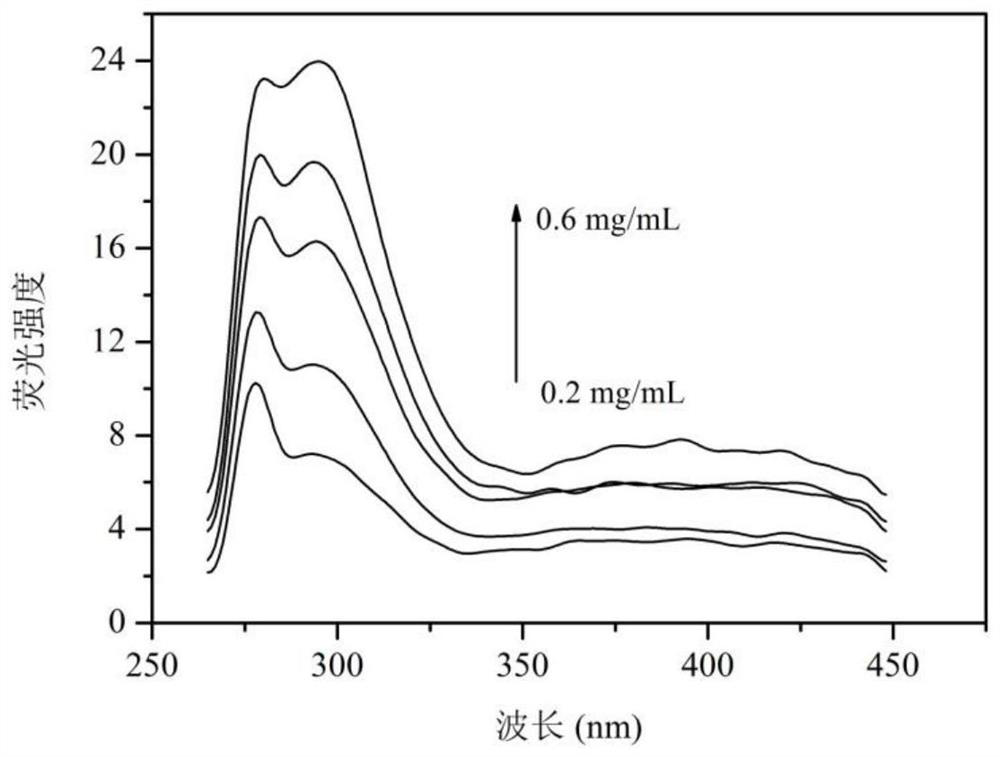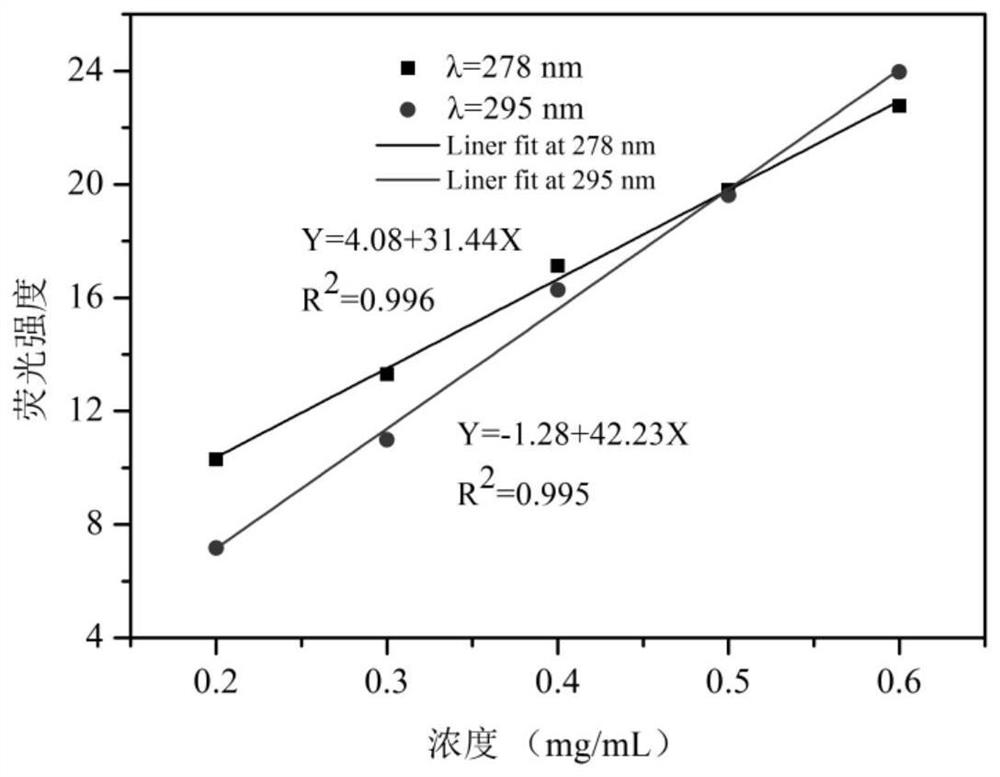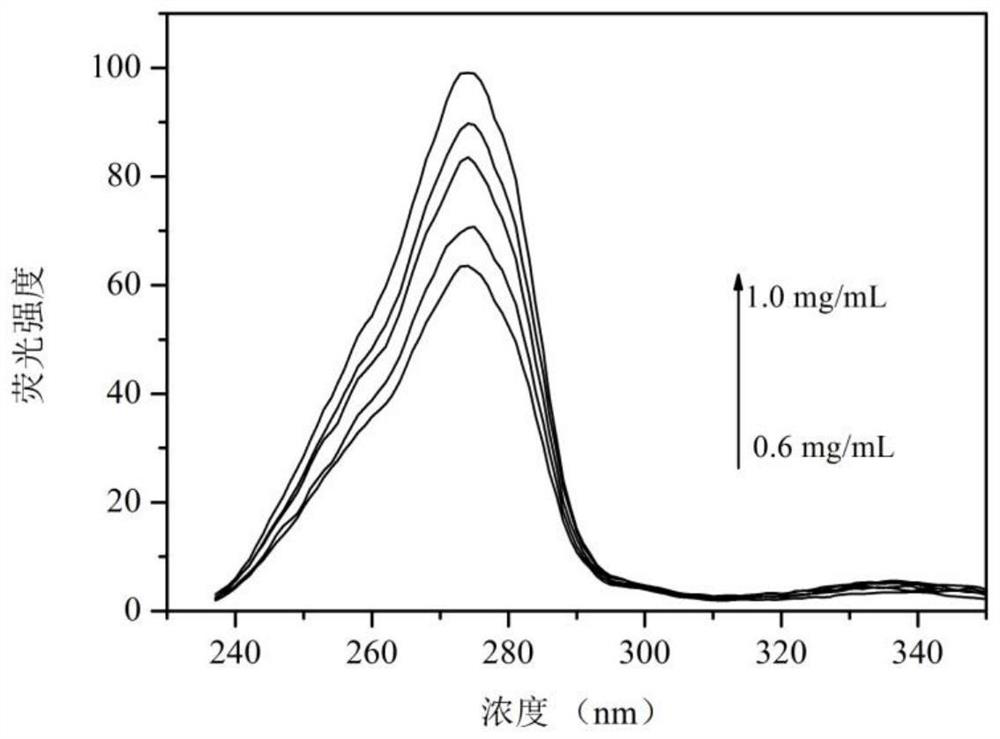Method for quantitatively detecting collagen by adopting fluorescence spectrum
A technique of quantitative detection and fluorescence spectroscopy, which is applied in the field of quantitative detection of collagen proteins by fluorescence spectroscopy, can solve the problems of easy errors and achieve good linearity and sensitive reproducibility
- Summary
- Abstract
- Description
- Claims
- Application Information
AI Technical Summary
Problems solved by technology
Method used
Image
Examples
Embodiment 1
[0035] Determination of Collagen Content in Bovine Hide Using Fixed Wavelength Fluorescence Scanning
[0036] (1) Take fresh cowhide, wash it with water after degreasing and dehairing, then cut into pieces and homogenate; weigh 10g of the homogenate, add 300mL of 0.5mol / L acetic acid and 0.1g of pepsin (activity value 1:10000), After acting at 4°C for 48h, centrifuge at 10000rpm for 15min. The supernatant was salted out with NaCl to a concentration of 3 mol / L. The precipitated sample was dissolved again in 0.5 mol / L acetic acid solution, and then salted out with 0.7 mol / L NaCl. The precipitate was redissolved in 0.5mol / L acetic acid, and dialyzed with 0.1mol / L acetic acid solution for 3 days. Finally, the sample was frozen for 48 hours with a freeze vacuum dryer (-55°C), and stored at 4°C for later use;
[0037] (2) Dissolving the collagen prepared in step (1) in 0.1mol / L acetic acid aqueous solution to prepare a 0.1-0.9mg / mL collagen solution, and standing at 4°C for 24h; ...
Embodiment 2
[0042] Determination of Collagen Content in Bovine Hide Using Simultaneous Fluorescence Spectroscopic Scanning
[0043](1) Take fresh cowhide, wash it with water after degreasing and dehairing, then cut into pieces and homogenate; weigh 10g of the homogenate, add 300mL of 0.5mol / L acetic acid and 0.1g of pepsin (activity value 1:10000), After acting at 4°C for 48h, centrifuge at 10000rpm for 15min. The supernatant was salted out with NaCl to a concentration of 3 mol / L. The precipitated sample was dissolved again in 0.5 mol / L acetic acid solution, and then salted out with 0.7 mol / L NaCl. The precipitate was redissolved in 0.5mol / L acetic acid, and dialyzed with 0.1mol / L acetic acid solution for 3 days. Finally, the sample was frozen for 48 hours with a freeze vacuum dryer (-55°C), and stored at 4°C for later use;
[0044] (2) Dissolving the collagen prepared in step (1) in 0.1 mol / L acetic acid aqueous solution to prepare a 0.2-0.6 mg / mL collagen solution, and standing at 4°...
Embodiment 3
[0049] Determination of Collagen Content in Bovine Hide Using Exogenous Fluorescent Probe Method
[0050] (1) Take fresh cowhide, wash it with water after degreasing and dehairing, then cut into pieces and homogenate; weigh 10g of the homogenate, add 300mL of 0.5mol / L acetic acid and 0.1g of pepsin (activity value 1:10000), After acting at 4°C for 48h, centrifuge at 10000rpm for 15min. The supernatant was salted out with NaCl to a concentration of 3 mol / L. The precipitated sample was dissolved again in 0.5 mol / L acetic acid solution, and then salted out with 0.7 mol / L NaCl. The precipitate was redissolved in 0.5mol / L acetic acid, and dialyzed with 0.1mol / L acetic acid solution for 3 days. Finally, the sample was frozen for 48 hours with a freeze vacuum dryer (-55°C), and stored at 4°C for later use;
[0051] (2) Dissolving the collagen prepared in step (1) in 0.1 mol / L acetic acid aqueous solution to prepare a 0.2-0.6 mg / mL collagen solution, and standing at 4°C for 24 hour...
PUM
| Property | Measurement | Unit |
|---|---|---|
| concentration | aaaaa | aaaaa |
Abstract
Description
Claims
Application Information
 Login to View More
Login to View More - R&D
- Intellectual Property
- Life Sciences
- Materials
- Tech Scout
- Unparalleled Data Quality
- Higher Quality Content
- 60% Fewer Hallucinations
Browse by: Latest US Patents, China's latest patents, Technical Efficacy Thesaurus, Application Domain, Technology Topic, Popular Technical Reports.
© 2025 PatSnap. All rights reserved.Legal|Privacy policy|Modern Slavery Act Transparency Statement|Sitemap|About US| Contact US: help@patsnap.com



